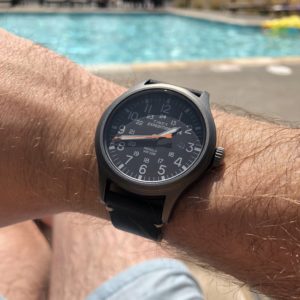 I know, I know—The Cramped is about analogue writing tools, not watches. But this post isn’t about watches, not really. It’s about choosing simple tools that do their job well. And it’s about eliminating necessary distractions. And it’s about refusing to be convinced that you need a certain thing to do other things that you’ve always been able to do without that first thing.
I know, I know—The Cramped is about analogue writing tools, not watches. But this post isn’t about watches, not really. It’s about choosing simple tools that do their job well. And it’s about eliminating necessary distractions. And it’s about refusing to be convinced that you need a certain thing to do other things that you’ve always been able to do without that first thing.
A little over a year and a half ago I bought my wife an Apple Watch for Christmas. She’d been wanting a fitness tracker, insisting she really just needed a Fitbit, but I thought she’d be happier with an Apple Watch instead. Why buy one thing when I could get her this other thing that does exactly what she wanted, but also more, and arguably looks a hell of a lot better? She loved the Apple Watch. It quickly became an indispensable tool for her. She’s a busy lady—at the time she was running a museum.
I, at the time, was spending all day in my home office, writing, mostly fiction. I didn’t need a computer on my wrist. I was intrigued by the idea, but felt little pull to get myself an Apple Watch. Until I did. After five months of observing how much my wife liked hers, I bought one for myself. Then I started managing and editing a popular print magazine, and the value of the Apple Watch for me became obvious.
I’m an active guy—I lift heavy three to four times a week, and I train jiu-jitsu three to five times a week (yes, sometimes I work out more than seven days a week). Even though I’m so active, for a long time I underutilized the fitness-tracking features of my Apple Watch. For me, the value came from things like notifications, the ability to control my music from my wrist, and, interestingly enough, quick access to the time (I’d never been much of a watch guy before).
Besides, the Apple Watch sucks at tracking the kinds of activities I do. It’s woefully inaccurate at tracking heart rate during lifting workouts (this is the fault of physics, not Apple), and wearing jewelry and other accessories during martial arts can be downright dangerous.
But then one day, a few months ago, I decided to go all-in on this tracking idea. I created some Workflows that would allow me to manually track my lifting and grappling workouts, using an algorithmically estimated calories-burned count. I wanted to see how long I could maintain a streak on the watch, filling all three of my rings—standing, calories burned, and amount of time spent exercising—every day. The stand and exercise goals are stagnant, but the calories-burned goal increases each week as you maintain the streak. My streak, for all three rings, lasted 66 days.
But there’s something grating about being tapped on the wrist every hour and being commanded to stop whatever you’re working on and stand for 60 seconds, to come out of a deep work session in order to fulfill an arbitrary goal. And, oh boy, the guilt one feels when they don’t get their caloric goal one day . . . it’s heavy. And if you miss two days, because you’re sick, or because you did spend two hours training but forgot to log it, or because you had a particularly tough sparring session and just knew, because your body told you—and you trust your body—that you needed to rest, to recover—well the Apple Watch finds that shameful, and it lets you know it finds that shameful.
And it turns out notifications for messages on your wrist aren’t much better. Sure, I’d rather hear from a real person than a computer, but I don’t want anybody to be able to come up to me while I’m working, headphones in, and tap me on the arm because they think what they have to say is more important than what I’m creating.
So I decided to stop wearing the Apple Watch for a week. When the week was over, I didn’t put it back on. I still lifted, I still sparred, and I even sprinted a few times. I sold the Apple Watch. I got $150 for it.
Which brings me to the Timex Expedition Scout. I bought it for $60, in a sort of slate-gray brass with a black leather strap. It looks good. I love the bright orange second hand, which is shaped like a hunting arrow, and the hour and minutes hands, which are white and gray and shaped like swords. I don’t have to charge the watch, and the watch does one specific thing really well: it tells me the time, whenever I need it.
It’s a lot like paper: For decades tech enthusiasts have been trying to convince us that there’s something better than paper. I was once convinced, but now I’m not. And in the last few years, they’ve started trying to convince us there’s something better than a traditional watch. I was briefly convinced, but now I’m not.
